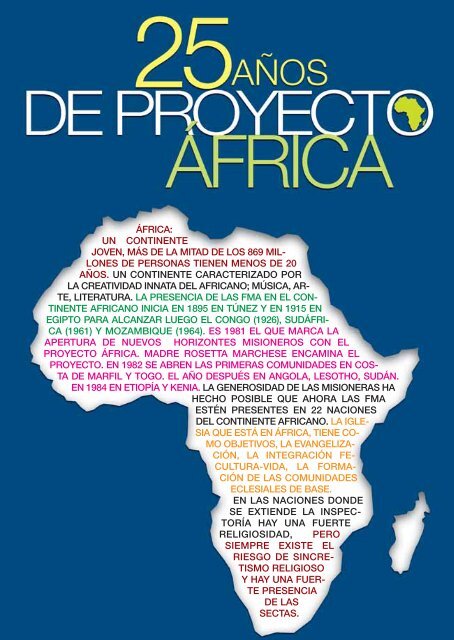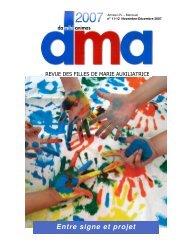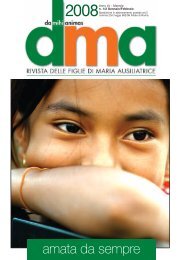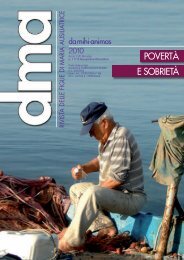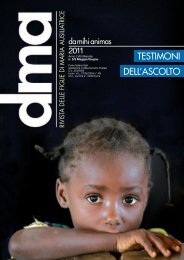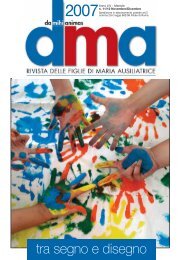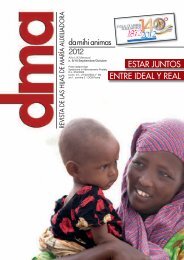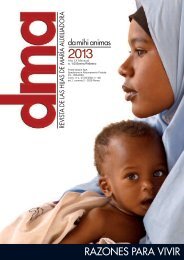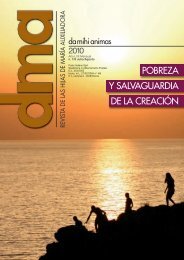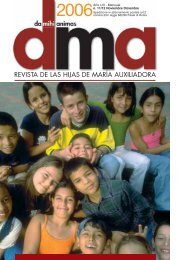áfrica: un continente joven, más de la mitad de los 869 mil
áfrica: un continente joven, más de la mitad de los 869 mil
áfrica: un continente joven, más de la mitad de los 869 mil
You also want an ePaper? Increase the reach of your titles
YUMPU automatically turns print PDFs into web optimized ePapers that Google loves.
ÁFRICA:<br />
UN CONTINENTE<br />
JOVEN, MÁS DE LA MITAD DE LOS <strong>869</strong> MIL-<br />
LONES DE PERSONAS TIENEN MENOS DE 20<br />
AÑOS. UN CONTINENTE CARACTERIZADO POR<br />
LA CREATIVIDAD INNATA DEL AFRICANO; MÚSICA, AR-<br />
TE, LITERATURA. LA PRESENCIA DE LAS FMA EN EL CON-<br />
TINENTE AFRICANO INICIA EN 1895 EN TÚNEZ Y EN 1915 EN<br />
EGIPTO PARA ALCANZAR LUEGO EL CONGO (1926), SUDÁFRI-<br />
CA (1961) Y MOZAMBIQUE (1964). ES 1981 EL QUE MARCA LA<br />
APERTURA DE NUEVOS HORIZONTES MISIONEROS CON EL<br />
PROYECTO ÁFRICA. MADRE ROSETTA MARCHESE ENCAMINA EL<br />
PROYECTO. EN 1982 SE ABREN LAS PRIMERAS COMUNIDADES EN COS-<br />
TA DE MARFIL Y TOGO. EL AÑO DESPUÉS EN ANGOLA, LESOTHO, SUDÁN.<br />
EN 1984 EN ETIOPÍA Y KENIA. LA GENEROSIDAD DE LAS MISIONERAS HA<br />
HECHO POSIBLE QUE AHORA LAS FMA<br />
ESTÉN PRESENTES EN 22 NACIONES<br />
DEL CONTINENTE AFRICANO. LA IGLE-<br />
SIA QUE ESTÁ EN ÁFRICA, TIENE CO-<br />
MO OBJETIVOS, LA EVANGELIZA-<br />
CIÓN, LA INTEGRACIÓN FE-<br />
CULTURA-VIDA, LA FORMA-<br />
CIÓN DE LAS COMUNIDADES<br />
ECLESIALES DE BASE.<br />
EN LAS NACIONES DONDE<br />
SE EXTIENDE LA INSPEC-<br />
TORÍA HAY UNA FUERTE<br />
RELIGIOSIDAD, PERO<br />
SIEMPRE EXISTE EL<br />
RIESGO DE SINCRE-<br />
TISMO RELIGIOSO<br />
Y HAY UNA FUER-<br />
TE PRESENCIA<br />
DE LAS<br />
SECTAS.
INICIAMOS NUESTRO VIAJE ENTRE LAS REALIDADES AFRICANAS<br />
PARTIENDO DE LA INSPECTORÍA MADRE DE DIOS DEL OESTE DE ÁFRICA AFO.<br />
ÉSTA COMPRENDE LAS NACIONES DE BENIN, COSTA DE MARFIL, MALÍ, TOGO.<br />
EL 1 DE ENERO DE 1991 SE CONVIERTE EN VISITADURÍA,<br />
EL 5 DE AGOSTO DE 1992 SE CONVIERTE EN INSPECTORÍA.<br />
CUATRO PAÍSES, OCHO COMUNIDADES, 1.732.052 KM 2 ,<br />
36,7 MILLONES DE HABITANTES IGUAL AL 5,5% DE ÁFRICA.<br />
AFO ES UNA MISIÓN QUE SE DESARROLLA AL SERVICIO DE LA VIDA,<br />
A TRAVÉS DE UNA EDUCACIÓN QUE EVANGELIZA, UNA EDUCACIÓN QUE<br />
PREPARA A LA VIDA CON: CENTROS PROFESIONALES<br />
(COCINA, PASTELERÍA, CURSOS DE PELUQUERÍA, CORTE Y CONFECCIÓN,<br />
INFORMÁTICA) ESCUELA TÉCNICA PROMOCIÓN FEMENINA ALFABETIZACIÓN,<br />
ESCUELA BÁSICA, ESCUELA PRIMARIA CENTRO JUVENIL, ORATORIOS<br />
UNA ATENCIÓN PARTICULAR ESTÁ RESERVADA<br />
A LA SITUACIÓN DE LAS NIÑAS Y DE LAS MUCHACHAS EXPLOTADAS<br />
A TRAVÉS DE LAS BARRACAS EN EL MERCADO DE DANTOPKA,<br />
LAS CASAS FAMILIA Y DE ACOGIDA DE COTONOU, LA CASA DE ACOGIDA DE<br />
ABIDJAN.<br />
UNA COMUNIDAD DE PERSONAS QUE CAMINAN JUNTAS<br />
HAY 48 HERMANAS, 5 NOVICIAS, 3 POSTULANTES, 3 ASPIRANTES, 23 NACIO-<br />
NALIDADES, EDAD MEDIA 46 AÑOS, 16 HERMANAS AFRICANAS, 8 DE VOTOS<br />
PERPETUOS.<br />
LOS RETOS: COORDINACIÓN EN LA ANIMACIÓN,<br />
INTERCULTURALIDAD, COMPROMISO SOCIO-POLÍTICO,<br />
EDUCACIÓN PARA LA PAZ Y LA TOLERANCIA.
El gran tam-tam<br />
tiene su voz.<br />
Pero también el pequeño tiene <strong>la</strong> suya.<br />
(proverbio africano)
HOGARES PARA QUIEN ES EXPLOTADO<br />
Des<strong>de</strong> 2001 <strong>la</strong>s FMA se ocupan en Cotonou<br />
(Benin) <strong>de</strong> <strong>la</strong>s niñas víctimas <strong>de</strong>l tráfico <strong>de</strong> menores.<br />
Empezaron con <strong>la</strong> apertura <strong>de</strong> <strong>un</strong> p<strong>un</strong>to <strong>de</strong><br />
acogida y <strong>de</strong> escucha en el Marché <strong>de</strong><br />
Dantokpa, don<strong>de</strong> cada día hay <strong>mil</strong>es <strong>de</strong> niñas<br />
vendidas por sus padres a alg<strong>un</strong>as tutoras que<br />
<strong>la</strong>s explotan. Son niñas <strong>de</strong> 6 a 13 años que están<br />
en el banco <strong>de</strong>l mercado o que todo el día dan<br />
vueltas con <strong>la</strong> mercancía en <strong>la</strong> cabeza. A menudo<br />
estas niñas se quedan sin instrucción, <strong>de</strong>sa-<br />
rraigadas <strong>de</strong> sus fa<strong>mil</strong>ias, sin cuidados médicos,<br />
víctimas a menudo <strong>de</strong> todo tipo <strong>de</strong> violencia y a<br />
veces vendidas a extranjeros.<br />
LA BARRACA EN EL MERCADO DE COTONOU<br />
El pequeño “centro” está situado <strong>de</strong>ntro <strong>de</strong> <strong>un</strong><br />
aparcamiento muy frecuentado en el corazón<br />
<strong>de</strong>l mercado, y consiste en <strong>un</strong>a barraca, dos<br />
locales hechos <strong>de</strong> chapas, <strong>un</strong>o preparado para<br />
el trabajo y el juego, el otro como au<strong>la</strong> esco<strong>la</strong>r<br />
para <strong>la</strong> primera alfabetización.<br />
En estos pocos metros cuadrados, en estos últimos<br />
años se han sucedido <strong>más</strong> <strong>de</strong> 1500 niñas.<br />
En <strong>la</strong> barraca abierta <strong>de</strong>s<strong>de</strong> <strong>la</strong>s 10 a <strong>la</strong>s 17 h. <strong>la</strong>s<br />
animadoras acogen y escuchan a <strong>la</strong>s niñas, les<br />
ofrecen <strong>un</strong> cobijo y poco a poco <strong>la</strong>s invitan a<br />
seguir <strong>los</strong> programas <strong>de</strong> alfabetización, <strong>la</strong>s c<strong>la</strong>ses<br />
<strong>de</strong> higiene, <strong>de</strong> corte y confección y les dan<br />
<strong>la</strong> posibilidad <strong>de</strong> tener momentos recreativos<br />
con música y juegos.<br />
LA OBRA EN ZOGBO<br />
Cuando <strong>la</strong>s niñas están en peligro, son<br />
acogidas en <strong>la</strong>s com<strong>un</strong>ida<strong>de</strong>s al <strong>la</strong>do<br />
opuesto <strong>de</strong> <strong>la</strong> ciudad don<strong>de</strong> <strong>la</strong>s Hermanas<br />
administran dos “foyers”: <strong>un</strong>o <strong>de</strong> primera<br />
acogida y el otro <strong>de</strong> formación.<br />
Cuando <strong>la</strong>s niñas llegan al centro <strong>de</strong> primera<br />
acogida, <strong>la</strong>s FMA se preocupan <strong>de</strong><br />
enten<strong>de</strong>r su situación, buscan a <strong>los</strong><br />
padres, hab<strong>la</strong>n con sus tutoras. Se les<br />
dan cursos <strong>de</strong> primera alfabetización y<br />
se intenta enseñarles alg<strong>un</strong>as activida<strong>de</strong>s<br />
útiles para <strong>la</strong> vida en <strong>la</strong> al<strong>de</strong>a, como<br />
<strong>la</strong> cocina, el corte y confección, <strong>la</strong>s técnicas<br />
para cultivar el huerto o para criar<br />
animales. Sobre todo se les da <strong>la</strong> posibilidad<br />
<strong>de</strong> encontrarse con <strong>un</strong>a figura<br />
distinta <strong>de</strong> adulto, correcto y que no <strong>la</strong>s<br />
explota. Muchas <strong>de</strong> estas niñas son<br />
ayudadas a reinsertarse en el contexto<br />
fa<strong>mil</strong>iar. Se ayuda a <strong>los</strong> padres, incluso<br />
financieramente, manteniendo <strong>los</strong> gastos<br />
para <strong>la</strong> esco<strong>la</strong>rización. Cuando <strong>la</strong>s niñas<br />
vuelven a sus al<strong>de</strong>as, siguen siendo seguidas,<br />
<strong>la</strong>s Hermanas visitan a <strong>la</strong>s fa<strong>mil</strong>ias ayudándo<strong>la</strong>s<br />
a creer en lo positivo <strong>de</strong> tener consigo a <strong>los</strong><br />
hijos.<br />
En el seg<strong>un</strong>do “foyer” <strong>la</strong>s FMA trabajan con<br />
aquel<strong>la</strong>s niñas cuya reinserción es <strong>más</strong> difícil.<br />
Aquí hay 35 sitios ocupados por quien frecuenta<br />
regu<strong>la</strong>rmente <strong>la</strong> escue<strong>la</strong> elemental o <strong>los</strong> cursos<br />
<strong>de</strong> corte y confección o <strong>de</strong> peluquería.<br />
Las Hermanas les ofrecen medios para que puedan<br />
ser autónomas y tengan <strong>la</strong> posibilidad <strong>de</strong><br />
hacer frente a <strong>la</strong> pobreza que es <strong>la</strong> primera<br />
causa <strong>de</strong>l tráfico <strong>de</strong> menores.


